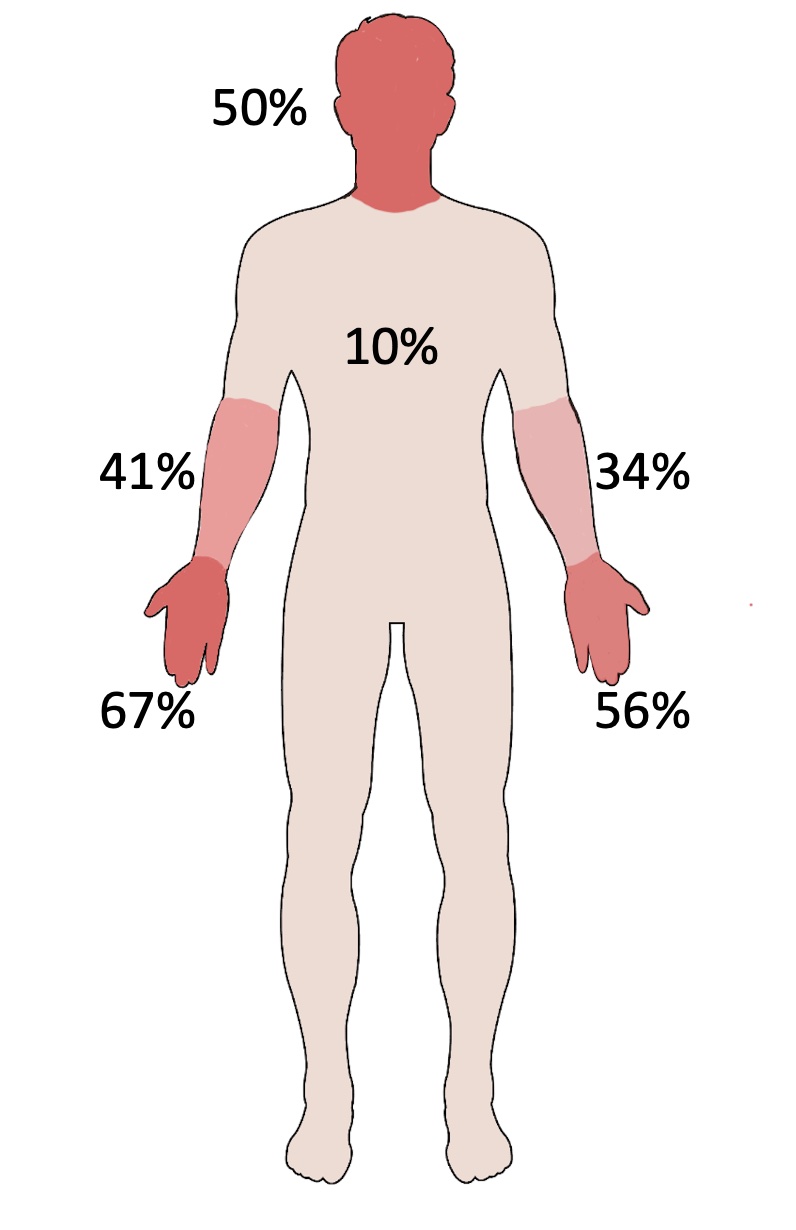Protection

Where the risk cannot be controlled by prevention or where there is a residual risk of injury then it may be necessary to consider mitigation to prevent injury to the worker. The requirement for and suitability of mitigation techniques must form an essential element of any risk assessment. In Chapter 3: Risk Assessments and the Four P Guide, there was a hierarchy of risk controls for electrical flashover and the final risk control measure in the hierarchy is Personal Protective Equipment. It is fairly obvious that PPE is not mentioned in the principles of prevention given in Chapter 3: Risk Assessments and the Four P Guide as PPE alone will not prevent the accident. It is therefore seen as a last line of defence but where used properly, there is evidence that it has prevented injury to individuals.

Figure 7.1 Distribution of Thermal Injuries
In this chapter, the main focus is on the selection of PPE for protection against arc flash and it will look at how this aligns with the risk assessment process. Although the intention is to inform about how arc flash PPE is selected and used, one objective is to simplify the selection process. In most situations, flame resistant PPE is surprisingly comfortable nowadays and can be worn as everyday workwear. If we follow the steps laid out in this guide so far, the residual risk should now be much less severe and hopefully minimised to a great extent. That means that should PPE be required as a final risk control measure, then this will be much lighter and less cumbersome. The wearing of PPE should be much more acceptable, not only in terms of user agreement but also in expense. Heavy duty PPE is expensive!
Non-flame-resistant clothing may ignite or melt at low incident energy values and once ignited will continue to burn after the electrical arc has been extinguished. Three seconds of burning material next to the flesh can result in serious full thickness burns. This means that ordinary clothing could actually become a hazard and for this reason it is well worth considering a policy of comfortable Flame Resistant (FR) clothing. There is research that shows that the hands, arms and face are the most commonly affected parts of the body in an arc flash incident. See Figure 7.1 (Source: Guideline for selection of personnel protective clothing when exposed to the thermal effects of an electric arc, International Social Security Association- Section Electricity, Koln, 2002) This is not surprising as these parts of the body are often exposed and are also much closer to the arc, special emphasis should be given to face and hand protection.
7.1 Standards for PPE in Europe
European Council Directive 89/656/EEC Use of Personal Protective Equipment covers the minimum health and safety requirements for the use by workers of personal protective equipment at the workplace. Laws in EU countries on the use of personal protective equipment (PPE) in the workplace are all based upon this directive. You can find the specific legislation in Chapter 16: Rules, Codes and Legislation for the UK and Ireland. Priority must be given to collective safety measures. PPE can only be used where the existing risks cannot be sufficiently limited by technical means or collective protection or work organization procedures. The employer must also provide the appropriate equipment free of charge and ensure that it is in good working order and hygienic condition.
PPE can only be prescribed after the employer has analysed and assessed the risks which cannot be avoided by other means. For arc flash this means an employer must consider other means of achieving safety prior to considering the use of PPE, such as the elimination of hazard, engineering controls and safe systems of work.
Issues of use, which must be part of the risk assessment process, must include ergonomics, sensory deprivation of user, continuing integrity of PPE and other injury mechanisms, including loss of hearing and sight. Heat stress is a particular concern with arc flash PPE as it may lead to fatigue at best and could lead to poor decision making, not a good thing when working near live conductors. This is one more reason to ensure that the risk assessment process is followed rigorously with the avoidance of over specified PPE. In addition, the health of the worker must be considered, bearing in mind that arc flash PPE will usually result in some restriction of the face. There could therefore be some physical and even psychological issues to take into account.
In addition to the above is the Regulation (EU) 2016/425 of the European Parliament and of the Council of 9 March 2016 on Personal Protective Equipment, repealing Council Directive 89/686/EEC. The regulation lays down requirements for the design and manufacture of personal protective equipment (PPE), which is to be made available on the market, in order to ensure protection of the health and safety of users and establish rules on the free movement of PPE in the European Union.